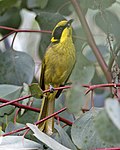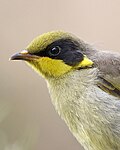mk
имиња во трошки


El melífago mariellu copetudo ye una especie d'ave australiana perteneciente al xéneru Lichenostomus.
 Esta páxina forma parte del wikiproyeutu Aves, un esfuerciu collaborativu col fin d'ameyorar y organizar tolos conteníos rellacionaos con esti tema. Visita la páxina d'alderique del proyeutu pa collaborar y facer entrugues o suxerencies.
Esta páxina forma parte del wikiproyeutu Aves, un esfuerciu collaborativu col fin d'ameyorar y organizar tolos conteníos rellacionaos con esti tema. Visita la páxina d'alderique del proyeutu pa collaborar y facer entrugues o suxerencies. El melífago mariellu copetudo ye una especie d'ave australiana perteneciente al xéneru Lichenostomus.
El menjamel de cresta groga (Lichenostomus melanops) és una espècie d'ocell australià pertanyent al gènere Lichenostomus i de la família dels melifàgids.
El menjamel de cresta groga (Lichenostomus melanops) és una espècie d'ocell australià pertanyent al gènere Lichenostomus i de la família dels melifàgids.
Aderyn a rhywogaeth o adar yw Melysor cribfelyn (sy'n enw gwrywaidd; enw lluosog: melysorion cribfelyn) a adnabyddir hefyd gyda'i enw gwyddonol Meliphaga melanops; yr enw Saesneg arno yw Yellow-tufted honeyeater. Mae'n perthyn i deulu'r Melysorion (Lladin: Meliphagidae) sydd yn urdd y Passeriformes.[1]
Talfyrir yr enw Lladin yn aml yn M. melanops, sef enw'r rhywogaeth.[2] Mae'r rhywogaeth hon i'w chanfod yn Awstralia.
Mae'r melysor cribfelyn yn perthyn i deulu'r Melysorion (Lladin: Meliphagidae). Dyma rai o aelodau eraill y teulu:
Rhestr Wicidata:
rhywogaeth enw tacson delwedd Aderyn cloch Seland Newydd Anthornis melanura Melysor aelfelyn Melidectes rufocrissalis Melysor Belford Melidectes belfordi Melysor bronfrith y mynydd Meliphaga orientalis Melysor brych Xanthotis polygrammus Melysor cefngrwm Meliphaga aruensis Melysor cefnfrown Ramsayornis modestus Melysor eurymylog Anthochaera phrygia Melysor Lewin Meliphaga lewinii Melysor melynwyrdd Lichmera argentauris Melysor tagellog coch Anthochaera carunculata Melysor tagellog melyn Anthochaera paradoxa Melysor yr Ynysoedd Louisiade Meliphaga vicinaAderyn a rhywogaeth o adar yw Melysor cribfelyn (sy'n enw gwrywaidd; enw lluosog: melysorion cribfelyn) a adnabyddir hefyd gyda'i enw gwyddonol Meliphaga melanops; yr enw Saesneg arno yw Yellow-tufted honeyeater. Mae'n perthyn i deulu'r Melysorion (Lladin: Meliphagidae) sydd yn urdd y Passeriformes.
Talfyrir yr enw Lladin yn aml yn M. melanops, sef enw'r rhywogaeth. Mae'r rhywogaeth hon i'w chanfod yn Awstralia.
The yellow-tufted honeyeater (Lichenostomus melanops) is a passerine bird found in the south-east ranges of Australia. A predominantly black and yellow honeyeater, it is split into four subspecies.
The yellow-tufted honeyeater was first described by the English ornithologist John Latham in 1801, and given two different binomial names: Muscicapa auricomis and Turdus melanops.[2][3] The latter name was retained as a nomen protectum, and the former a nomen oblitum, as the epithet melanops has been used consistently for over a century. It belongs to the honeyeater family Meliphagidae. More recently, DNA analysis has shown honeyeaters to be related to the Pardalotidae, and the Petroicidae (Australasian robins) in a large corvid superfamily;[4] some researchers include all these families in a broadly defined Corvidae. The generic name Lichenostomus is derived from the Ancient Greek leikhēn 'lichen, callous' and stoma 'mouth'; the specific epithet melanops derives from Ancient Greek melas 'black' and opsis 'face'.[5]
Four races are recognised:
The yellow-tufted honeyeater is 17–23 cm (6.7–9.1 in) long, with females usually smaller.[8] It has a bright yellow forehead, crown and throat, a glossy black mask and bright golden ear-tufts.[9] The back is olive-green to olive-brown on wings and tail, and the underparts are more olive-yellow.[8][9] The bill and gape are black, eyes brown, and legs grey-brown.[10][11]
The yellow-tufted honeyeater occurs from south-east Queensland through eastern New South Wales and across Victoria. [12][8][13] Its preferred habitats are dry open sclerophyll forests and woodlands dominated by eucalypts with shrubby undergrowth, as well as mallee, brigalow and cypress-pine (Callitris).[11][12]
The helmeted honeyeater subspecies is largely restricted to dense vegetation along riverbanks, dominated by the mountain swamp gum (Eucalyptus camphora) with a dense understorey of woolly tea-tree (Leptospermum lanigerum), scented paperbark (Melaleuca squarrosa), saw-sedge (Gahnia), ferns and tussock grasses.[14][9][11]
Yellow-tufted honeyeaters are a noisy, active species in colonies from a few up to a hundred.[12] It aggressively defends territories around flowering trees.[12] It has a great variety of calls from a warbled "tui-t-tui-t-tui", a whistled "wheit-wheit", a sharp "querk" to a harsh contact-call "yip" or "chop-chop".[10][9][12]
The diet of the yellow-tufted honeyeater is primarily arthropods, such as a variety of insects and spiders, and occasionally snails.[11] It also feeds on lerps and honeydew, nectar and sap flows from eucalypts, occasionally fruit and flowers.[12][9][6] It takes insects in flight and by probing the bark of tree-trunks and limbs.[12]
Breeding takes place between July and March (mostly from September to January), with one or two broods each season.[12] The nest is a cup-shaped structure of dried grasses, bits of bark and other plant material, bound with spider webs and lined with fur and feathers, hung by its rim in dense shrubbery or regrowth.[12] Two or three eggs, each measuring 23 mm × 17 mm (0.91 in × 0.67 in), are laid, pinkish in colour, blotched with pale reddish- or buff-brown.[9][15] The eggs are incubated mostly by the female for 14-16 days.[11] The nestlings are brooded by the female and fed by both sexes and any helpers, fledging at 13-15 days post-hatch and usually becoming independent by 6 weeks.[12][11] The nests are parasitized by the fan-tailed cuckoo (Cacomantis flabelliformis), pallid cuckoo (Cacomantis pallidus) and shining bronze-cuckoo (Chrysococcyx lucidus).[11]
Yellow-tufted honeyeaters, as a species, are not listed as threatened on the Australian Environment Protection and Biodiversity Conservation Act 1999 or on any state-based legislation. However, at the subspecies level, the helmeted honeyeater (L. m. cassidix) is considered to be threatened:
 Yellow-tufted honeyeater near Lithgow, New South Wales
Yellow-tufted honeyeater near Lithgow, New South Wales The yellow-tufted honeyeater (Lichenostomus melanops) is a passerine bird found in the south-east ranges of Australia. A predominantly black and yellow honeyeater, it is split into four subspecies.
El mielero orejigualdo (Lichenostomus melanops)[2] es una especie de ave paseriforme de la familia Meliphagidae endémica de Australia.
El mielero orejigualdo (Lichenostomus melanops) es una especie de ave paseriforme de la familia Meliphagidae endémica de Australia.
Lichenostomus melanops Lichenostomus generoko animalia da. Hegaztien barruko Meliphagidae familian sailkatua dago.
Lichenostomus melanops Lichenostomus generoko animalia da. Hegaztien barruko Meliphagidae familian sailkatua dago.
Kultakruunumesikko (Lichenostomus melanops)[2] on mesikoiden heimoon kuuluva varpuslintu.
Kultakruunumesikkoa tavataan Australian itä- ja kaakkoisosissa. Nimialalajia on kuvattu yleiseksi, mutta alalajia cassidix harvinaiseksi. Kultakruunumesikko on luokiteltu elinvoimaiseksi.[1]
Kultakruunumesikko (Lichenostomus melanops) on mesikoiden heimoon kuuluva varpuslintu.
Lichenostomus melanops
Le Méliphage cornu (Lichenostomus melanops) est une espèce de passereau méliphage originaire des régions montagneuses du sud-est de l'Australie depuis le sud-est du Queensland jusqu'au sud-est de l'Australie-Méridionale en passant par l'est de la Nouvelle-Galles du Sud et le Victoria. Oiseau essentiellement noir et jaune, il est subdivisé en trois sous-espèces.
C'est un petit oiseau de 17 à 23 centimètres de longueur (en moyenne 20) pour une masse de 20 grammes. Le mâle est un peu plus gros que la femelle. Le plumage est vert olive sur le dos et vert jaunâtre sur le ventre. Le front, la couronne et la gorge sont jaunes et les joues sont noires. Cet oiseau présente une huppe de plumes jaunes sur les oreilles et le front[1].
Cet oiseau est représenté par trois sous-espèces :
Cet oiseau se nourrit d'insectes et de nectar.
Il vit en couples ou en petits groupes.
Il se reproduit de juillet en janvier. La femelle pond deux ou trois œufs qu'elle couve dans un nid situé à faible hauteur.
Lichenostomus melanops
Le Méliphage cornu (Lichenostomus melanops) est une espèce de passereau méliphage originaire des régions montagneuses du sud-est de l'Australie depuis le sud-est du Queensland jusqu'au sud-est de l'Australie-Méridionale en passant par l'est de la Nouvelle-Galles du Sud et le Victoria. Oiseau essentiellement noir et jaune, il est subdivisé en trois sous-espèces.
De geelpluimhoningeter (Lichenostomus melanops) is een zangvogel uit de familie Meliphagidae (honingeters).
De vogel is 16,5 tot 21 cm lang en weegt 16,6 tot 40 g. De ondersoort L. m. cassidix is 7 tot 17% langer en 40 tot 43% zwaarder dan de nominaat. De nominaat is geelgroen bovenop de kop en heeft een donker masker rond het oog. Deze zwarte veren hebben rond de oorstreek een duidelijk zichtbare, geel gekleurd uiteinde, een soort oorpluim. De kin en de keel zijn geel met fijne zwarte streepjes. De borst en buik zijn verder olijfkleurig lichtbruin met een gelige waas. Van boven is de vogel donker olijfbruin. De randen van de vleugelveren zijn geel. De poten zijn grijs en de snavel is zwart. De ondersoort L. m. cassidix is gemiddeld groter, het geel is feller van kleur, op de kruin is een duidelijke kuif en het zwart van het masker is groter dan bij de andere ondersoorten.[2]
Deze soort is endemisch in Australië en telt 3 ondersoorten:
De geelpluimhoningeter (Lichenostomus melanops) is een zangvogel uit de familie Meliphagidae (honingeters).
Gulduskhonningeter (Lichenostomus melanops) er en fugl i slekten Lichenostomus i familien honningetere. Den er endemisk til det sørøstlige Australia.
Det er beskrevet tre underarter av gulduskhonningeter[3]:
Gulduskhonningeter (Lichenostomus melanops) er en fugl i slekten Lichenostomus i familien honningetere. Den er endemisk til det sørøstlige Australia.
Gultofsad honungsfågel[2] (Lichenostomus melanops) är en fågel i familjen honungsfåglar inom ordningen tättingar.[3] IUCN kategoriserar arten som livskraftig.[1]
Gultofsad honungsfågel delas in i tre underarter i två grupper med följande utbredning:[3]
Gultofsad honungsfågel (Lichenostomus melanops) är en fågel i familjen honungsfåglar inom ordningen tättingar. IUCN kategoriserar arten som livskraftig.
Gultofsad honungsfågel delas in i tre underarter i två grupper med följande utbredning:
melanops/meltoni-gruppen L. m. meltoni – centrala och östra Queensland till New South Wales till sydöstliga South Australia L. m. melanops – östra New South Wales (centrala Lismore till Jervis Bay) L. m. cassidix – södra och centrala Victoria (Yellingbo distrikt i västra Gippsland)



Lichenostomus melanops là một loài chim trong họ Meliphagidae.[4]
Lichenostomus melanops là một loài chim trong họ Meliphagidae.